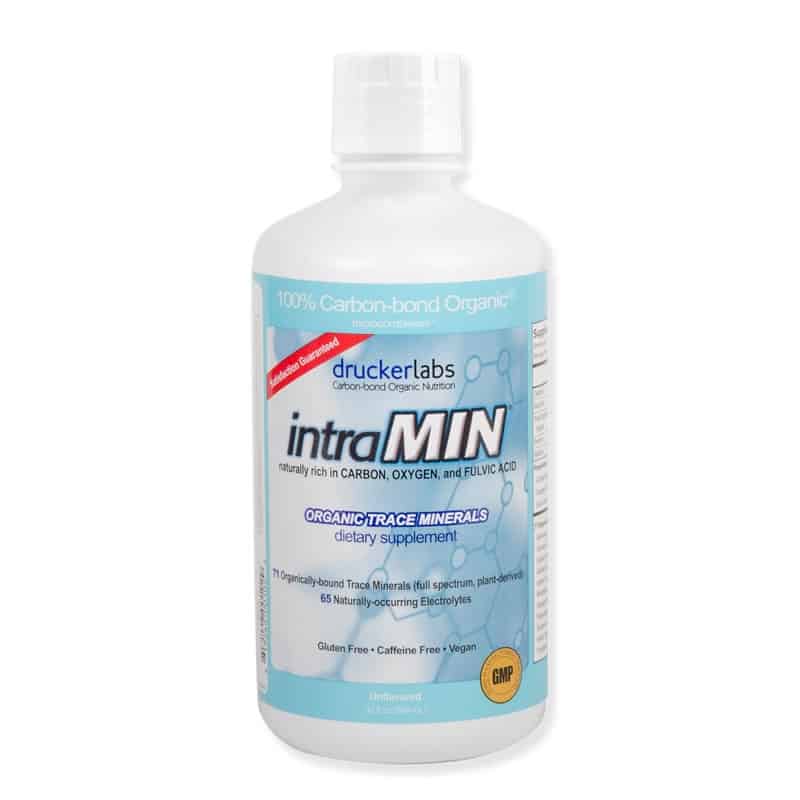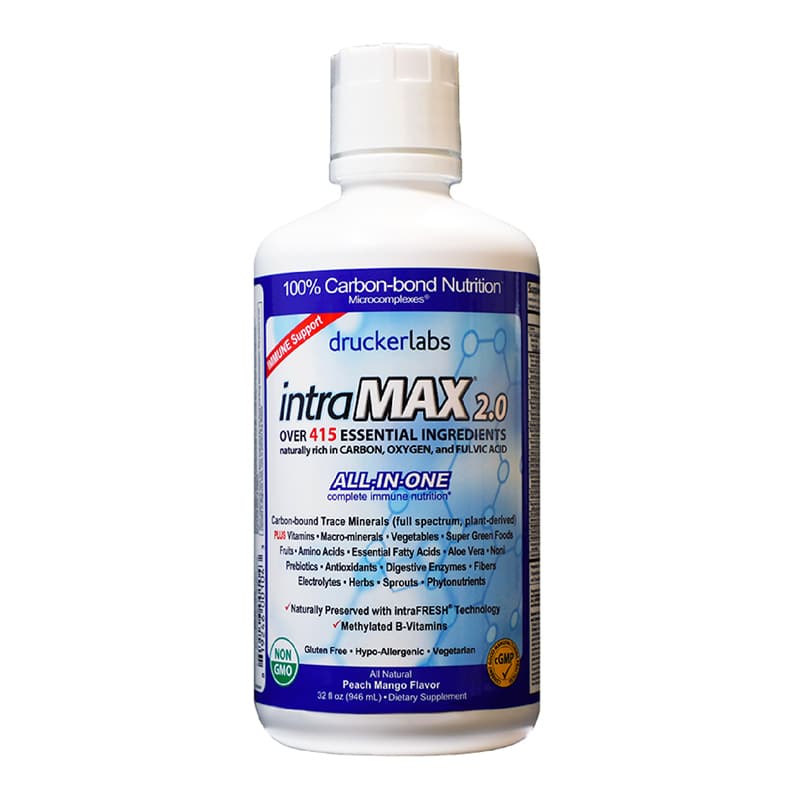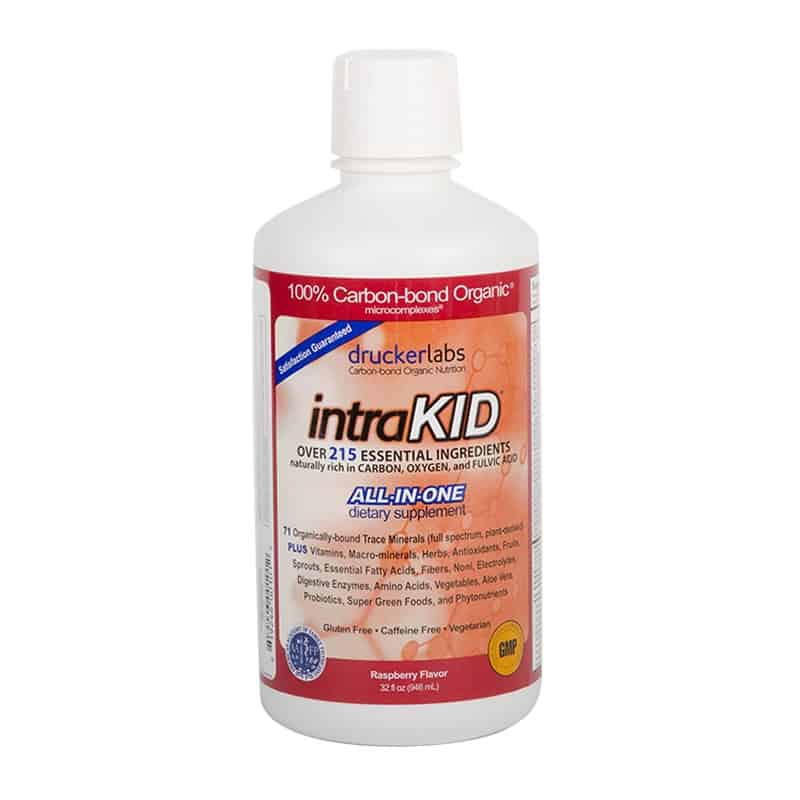No products in the cart.
Drucker Labs intraMIN In-depth Synopsis
Into Naturally Chelated intraMIN With 100%Carbon-Bond Organic, Homeostatic Soil-based Micro-complexes With Unique and Proprietary intraCELL Technology.
In order to assimilate a trace mineral, it must be chelated, it must be organic and it must be in an ionic form. Nature does this through plants and Drucker Labs intraCELL V Technology is derived from humic plants. Drucker Labs intraCELL V Technology contains soil-based micro-complexes that are derived from 100% organic plant sources and thus are ultra dissolved, organically complexed trace minerals. The minerals are chelated by nature with fulvic acid which is the strongest chelating agent known to man. Since the trace mineral ions have been chelated by nature, they are virtually 100% bioavailable. This is an important point to remember as it is the distinguishing factor between a mineral the body can utilize and a mineral derived from a rock formation, a salt water supply such a the Great Salt Lake, a deposit of salts from the earth or a mineral complex produced by combining various minerals in water and sold as mineral or trace mineral products. These inorganic products are NOT readily assimilated by the body as they are generally NOT chelated with an organic amino acid or protein. The body can only assimilate about 10% of an inorganic mineral complex.
Why do we need organic minerals? Because of soil depletion. Soil depletion occurs when chemical fertilizers kill the microorganisms in the soil that produce minerals for the plants. When an organic humus bed is destroyed, plants grown in that soil lack minerals as documented in 1936 by Dr. Northen in Senate Document 264. Without key trace minerals, the body cannot utilize amino acids, fats and vitamins properly. Minerals are indispensable to every organ, gland and muscle in the body. Without minerals, life cannot exist as they are the stimulus that produces energy and are required for all life functions. Trace mineral products generally have a metallic taste. Drucker Labs has found a way to combine these organic trace minerals with natural flavors to make them taste good. With 71 different minerals which are extracted from an ancient organic humus bed that was living organic matter and near 100% bioavailable., Drucker Labs products based on intraCELL V Technology and Fulvic Acid provide the trace minerals missing from today’s foods.
In-depth Synopsis
Into Naturally Chelated Carbon-Bond Organic, Homeostatic Soil-Based Micro-complexes With Unique & Proprietary intraCELL Technology
By Dr. Richard A. Drucker, M.S., ND, Ph.D. and Blayne Saunders
Within our intraMIN and intraMAX with naturally occurring, carbon-bond organic, Homeostatic Soil-based micro-complexes, we have detected with both Carbon and Proton Nuclear Magnetic Resonance (NMR) testing the presence of the following:
- Methyls– Organic based monovalent hydrocarbon radicals commonly associated with anaerobic diagenesis.
- Aromatic Protonates– Organic based aromatic carbon; hydrogen/carbon, aromatic compounds.
- Heterocyclics– A closed ring structure in which one or more of the atoms in the ring is an element other than carbon.
- Carbonyls– CO bivalent radical; any of a series of Organic metal compounds containing this radical.
- Carboxyls– COOH, Organic acids. (Fatty acids), carboxylic carbon
- Quinones– A conjugated cyclic diketone, with one to several six-membered carbon rings, produced in diagenesis.
- Ketone-Ketene-Like Carbonyls– Organic chemical compound containing the divalent carbonyl group CO in combination with two hydrocarbon radicals.
- Esters (flavored versions only)– Any of a class of Organic compounds corresponding to the inorganic salts formed from an acid by the replacement of hydrogen by an alkyl radical.
These carbon-bond microcomplexes are identified within the chemical structure of the above families and descriptions described above. All of them are formed naturally and organically during various stages of diagenesis. These organic complexes are very unique and extremely complex. Physicists researching humic, organic substances explain that they are some of the most complex, intricate and chelated (99% absorbable) compounds on earth. Dr. Doug Leber, inventor of the Computronix Electro Dermal Screening Analysis and Equipment and Dr. Murray and Linder, associates of the Physical Chemistry Dept. at University of Capetown, attempted to duplicate these complexes, but could not. The world renowned, Dr. Boris Levinsky speaks of these microcomplexes as follows:
“The property of these remarkable combinations are so unique that even if we joined the efforts of all chemists of the world, we could not manage to synthesize anything similar.” Throughout this century, researchers from around the world have concluded that organic, Soil-based microcomplexes (i.e. humic, organic complexes), due to their unique structure and varied reactive and adaptive characteristics, are a major key to organic chemical reactions. These reactions include polymerization, depolymerization, catalytic, photolytic, residual enzymatic, interaction with organic chemicals, metal and mineral ions, and biological designs. The bottom line is this: Organic, homeostatic soil-based microcomplexes play a major important role in speciation, immobilization, transport, bioavailability and bio-chemical cycling of organic and inorganic matter throughout all life forms in the earth’s environment.
The cycle of production and the action of organic microcomplexes is continuous, if left to occur naturally. The microcomplexes are formed by microbes digesting and processing carbonaceous matter, originating mostly from plants and plant residues. These complexes reach out and transform inorganics into organics. This action enriches the original microcomplexes which become the key building blocks for the next generation of plants. These microcomplexes become part of the structure integrated into the food cells of the plants that animals and humans eat. As the animal and plant cycle ends, their matter becomes again food for microbes and so the cycle continues. Can this cycle be disrupted? Yes! The cycle depends totally upon the action of beneficial microbial life. Agricultural practices must allow nature to complete the annual replacement of organic microcomplexes, or agricultural practices must include feeding the microbes the correct plant matter to produce these organic microcomplexes.
These are the only two ways to maintain organic microcomplexes in our foods. It is curious to note that no society has existed, with substantial population and health, for more than several hundred years if that society has not practiced one of the two methods of maintaining organic microcomplexes in their foods. Maintaining 100% organic microcomplexes is called bio-intensive agriculture. It replaces nearly 100% of the soil’s nutrients extracted by crops grown each year. We have not practiced this kind of agriculture in America for over 150 years. Western agriculture for most of this century is at war with microbial life. Dr. Lewis Kervran states “The present form of agriculture, to which our biological agriculture is opposed, leads to the ruin of soil and health and will eventually bring about the death of humanity.” This warning is real. Consider these facts:
- Since 1950, the practice of Western agriculture in China has destroyed 30% of croplands which had produced, with bio-intensive practices, healthful crops for over 6,000 years.
- U.S. Agricultural practices destroy 6 lbs. of soil for every lb. of food produced.
- Even certified organic farming practices deplete the soil 7 to 70 times faster than nature restores it. Regular farming practices deplete the soil 8 to 80 times faster than nature restores it.
From the early part of this century, we have depleted virtually ALL of the naturally occurring, organic Soil-based microcomplexes from our soils. Thus, the organic microcomplexes depleted from soils are no longer in our foods. This is why the 100% naturally occurring, organics Soil-based microcomplexes are now the “missing link” to good health. We have found a way to incorporate 100% organic, Homeostatic Soil-based microcomplexes into our products. The chances that you can obtain these naturally occurring organic, Homeostatic Soil-based, microcomplexes from the grocery store or health food store shelves is nearly zero.
intraMIN and intraMAX are the most powerful, readily absorbable and utilized carbon-bond organic mineral supplement you can buy. They naturally contain over 72 chelated (100% absorbable form) fulvic poly-electrolyte minerals and organic, Homeostatic Soil-based microcomplexes. These microcomplexes contain a wide variety of organically complexed components in the form of: Methyl’s, Aromatic Protonates, Heterocyclics, Carbonyls, Carboxyls, Quinones and Ketone-Ketene-like Carbonyls. These microcomplexes provide the 72 chelated, minerals and elements in a natural, fulvic poly-electrolyte structure for maximum, absorption and utilization. They also contain fulvic acid which is a naturally occurring electrolyte and bio-activator.
IntraMIN and intraMAX with 100% carbon-bond organic, Soil-based microcomplexes contain naturally chelated, trace minerals, elements and poly-electrolytes which are critically necessary for:
- Proper composition of body pH, and Electrolytes;
- Formation of healthy blood and bones;
- Maintenance of healthy nerve function;
- Building and repair of muscles, tissues, joints, ligaments, tendons, etc.;
- Proper activation and assimilation by our bodies of other vitamins, minerals, amino acids, enzymes, glycogens, etc.;
- Reducing “Free Radical” damage to our cells, thereby slowing the aging process;
- Proper detoxification of inter-cellular metabolic wastes;
- Providing each cell with a neuro-electrical and intercellular catalyst to assist in the transport of over, chelated minerals, poly-electrolytes, microcomplexes and other vital nutrients into our cells;
- Support for natural healing
- Maximum energy, strength and stamina.
Below are the functions of the critical organic micro-complexes identified in research data and the important benefits for the human body:
Polymerization-depolymerization
Polymerization is the process of joining two or more like molecules to form a more complex molecule. This more complex molecule often has different properties. Depolymerization is the opposite action.
Micro-complexed molecules are natural organic structures. The body, and especially the cells, readily accept these micro-complexed molecules in ALL stages of digestion. Through polymerization, Organic microcomplexes combine with mineral molecules and trace elements to make them part of the microcomplexes’ own structure. This action makes the mineral molecules and trace elements available to the cell in organic form. In the same process, organic microcomplexes combine with food nutrients, enzymes, coenzymes, peptides, amino acids, herbal extracts, phytonutrients, and other beneficial molecules and transports these fractions into the cell. Organic microcomplexes also stimulate depolymerization of nutritional complexes or compounds of excessive size or complexity that enter the body. This process makes the oversize and complex compounds available to the body’s cells. Depolymerization is one process utilized by organic micro-complexes to break down toxic pollutants changing them to simpler, now harmless compounds.
Catalytic Action
An agent which provides the speeding up or slowing of a chemical process without entering into the process. ORGANIC micro-complexes play a very important role in this function!
Many minerals and trace elements are required as catalysts for basic chemical processes inside the cell. Micro-complexes have an abundant inventory of 100% natural, organically complexed minerals and trace elements, to provide these important catalysts.
Enzyme Stimulus
Enzymes are protein-like or protein substances that provide organic catalysts to speed up chemical reactions within the cell.
Carbon-bond organic micro-complexes stimulate enzymatic reactions and the formation of enzymes in the cell. Enzyme reactions are the chemical processes involved in the life sustaining functions of the cell. ORGANIC micro-complexes have a unique structure and varied reactive and adaptive characteristics that aid these critical enzymatic reactions.
Immobilization, Speciation & Bioavailability
Immobilization: Our Carbon-bond organic, Soil-based micro-complexes help fix and stabilize phytonutrients, enzymes and coenzymes, peptides, amino acids, inorganic antibiotics, oxygen, and other nutrients originating from plants and microbial sources.
Speciation: Microcomplexes form a NEW species of complexes from food sources, inorganics, nutritionals and other dietary sources. Without our organic microcomplexes, these sophisticated complexes would not be available to your digestive system or cells.
Bioavailability: There is probably no other single complex or supplement which you could use in minute amounts internally or externally, that will do more to improve the bioavailable action of ALL foods, nutrients enzymes, amino acids, phytonutrients, nutraceuticals, etc. you digest or apply.
Note:
The information in this paper is for information purposes only and has not been evaluated by the Food and Drug Administration. This information and these products are not intended to diagnose, treat, cure or prevent any disease.







